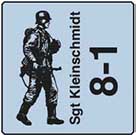Neilster
Posts: 2890
Joined: 10/27/2003
From: Hobart, Tasmania, Australia
Status: offline

|
quote:
Go229
Weight (empty / laden) : 4,600 / 9,000 kg.
Speed : 977 km/h.
Climb rate : 1,320 m/mn.
Ceiling : 16,000 m.
Bomb Load : 0 kg.
Range : 635 km.
Range with Aux Tanks : 3170 km.
Armament : 4 x 30 mm cannons.
Well that bomb load is plain wrong. Here's the Go 229 (Ho-229) entry on Wikipedia, with my emphasis in bold.
The Horten Ho 229 (often erroneously called Gotha Go 229 due to the identity of the chosen manufacturer of the aircraft) was a late-World War II prototype flying wing fighter/bomber, designed by Reimar and Walter Horten and built by Gothaer Waggonfabrik. It was a personal favourite of German Luftwaffe chief Reichsmarschall Hermann Göring, and was the only plane to come close to meeting his infamous performance requirements.
Contents [hide]
1 History
2 Variants
3 Specifications (Horten Ho 229A (V3), manufacturer estimates)
4 References
5 External links
6 Related content
[edit]
History
In the early 1930s, the Horten brothers had become interested in the flying wing design as a method of improving the performance of gliders. The German government was funding glider clubs at the time because production of powered aircraft was forbidden by the Treaty of Versailles after World War I. The flying wing layout removes any "unneeded" surfaces and, in theory at least, leads to the lowest possible drag. A wing-only configuration allows for a similarly performing glider with wings that are shorter and thus sturdier, and without the added drag of the fuselage.
In 1943, Reichsmarschall Göring issued a request for design proposals to produce a bomber that was capable of carrying a 1,000 kg (2,200 lb) load over 1,000 km (620 mi) at 1,000 km/h (620 mph); the so called 1000/1000/1000 rule. Conventional German bombers could reach Allied command centres in Great Britain, but were suffering devastating losses from Allied fighters. At the time there was simply no way to meet these goals — the new Jumo 004B turbojets could give the required speed but had excessive fuel consumption.
The Hortens felt that the low-drag flying wing design could meet all of the goals: by reducing the drag, cruise power could be lowered to the point where the range requirement could be met. They put forward their private (and jealously guarded) project, the Ho IX, as the basis for the bomber. The Government Air Ministry (Reichsluftfahrtministerium) approved the Horten proposal but ordered the addition of two 30 mm cannon, as they felt the aircraft would also be useful as a fighter due to its estimated top speed being significantly higher than that of any Allied aircraft.
The first Ho IX V1, which was an unpowered glider, flew on 1944-03-01. It was followed in December 1944 by the Jumo 004-powered Ho IX V2 (the BMW 003 engine was preferred but unavailable at the time). Göring believed in the design and ordered a production series of 40 aircraft at Gotha with the RLM designation Ho 229 before it had taken to the air under jet power. The program was undeterred when Ho IX V2 crashed due to engine failure on 1945-02-18 after only two hours of flying time. In fact, an order was put in for further prototypes and 20 pre-production aircraft. On 1945-03-12, Ho 229 was included into the Jägernot-programm for accelerated production of inexpensive "wonder weapons."
During the final stages of the war, the US military initiated Operation Paperclip which was an effort by the various intelligence agencies to capture advanced German weapons research, and to deny that research to advancing Soviet troops. A Horten glider and the Ho 229 V3, which was undergoing final assembly, were secured and sent to Northrop Corporation in the United States for evaluation. Northrop was chosen because of their experience with flying wings — inspired by the Horten brothers' pre-war record-setting glider, Jack Northrop had been building flying wings since the 1939 N-1M.
Northrop's small one-man prototype (N9M-B) and a Horten flying wing glider (Ho IV) are located in the Planes of Fame museum in Southern California. The only surviving Ho 229 airframe, the V3, is located at the National Air and Space Museum's Paul E. Garber Facility in Suitland, Maryland. Several partial airframes found on the assembly line were destroyed by American troops to prevent capture by the advancing Soviet forces.
Ho 229 was of mixed construction with the center pod made from welded steel tube and wing spars built from wood. The entire aircraft was covered with carbon-fiber impregnated plywood panels. Whether this was done for reasons of stealth or simply because late-war Germany experienced shortages of metals and Hortens needed to reinforce the plywood for trans-sonic flight is a matter of largely unreferenced debate and speculation. Control was achieved with elevons and spoilers. The aircraft utilized retractable tricycle landing gear and a brake parachute for landings. The pilot sat on a primitive ejection seat.
[edit]
Variants
Ho IX V1
Unpowered glider, 1 built.
Ho IX V2
First prototype, 1 built.
Ho 229 V3
Revised air intakes, engines moved forward to correct longitudinal imbalance, 1 captured in production.
Ho 229 V4
Proposed two-seat night fighter, not built.
Ho 229 V5
Proposed two-seat night fighter, not built.
Ho 229 V6
Projected definitive single-seat fighter version, not built.
Ho 229 V7
Projected two-seat trainer, not built.
Ho 229A-0
Projected expedited production version based on Ho 229 V3, not built.
[edit]
Specifications (Horten Ho 229A (V3), manufacturer estimates)
Data from The Great Book of Fighters[1]
General characteristics
Crew: One
Length: 7.47 m (24 ft 6 in)
Wingspan: 16.76 m (55 ft 0 in)
Height: 2.81 m (9 ft 2 in)
Wing area: 50.20 m² (540.35 ft²)
Empty weight: 4,600 kg (10,141 lb)
Loaded weight: 6,912 kg (15,238 lb)
Maximum Take-Off Weight: 8,100 kg (17,857 lb)
Powerplant: 2× Junkers Jumo 004B turbojet, 8.7 kN (1,960 lbf) each
Performance
Maximum speed: Mach 0.92, 977 km/h (607 mph) at 12,000 m (39,370 ft)
Combat radius: 1,000 km (620 mi)
Ferry range: 1,900 km (1,180 mi)
Service ceiling: 16,000 m (52,000 ft)
Rate of climb: 22 m/s (4,330 ft/min)
Wing loading: 137.7 kg/m² (28.2 lb/ft²)
Thrust/weight: 0.26
Armament
2x 30 mm MK 108 cannon
R4M rockets
2x 500 kg (1,100 lb) bombs
I don't think it's erroneous to use the Go 229 nomenclature (as stated at the beginning of this entry) but this aircraft was clearly a fighter-bomber and it's a pretty serious hole to have this counter with a ridiculously high air-to-air rating and no air-to-ground rating. I'll be changing the CSV file.
Cheers, Neilster

 Attachment (1) Attachment (1)
< Message edited by Neilster -- 5/22/2006 8:37:48 AM >
|
 Printable Version
Printable Version





















 New Messages
New Messages No New Messages
No New Messages Hot Topic w/ New Messages
Hot Topic w/ New Messages Hot Topic w/o New Messages
Hot Topic w/o New Messages Locked w/ New Messages
Locked w/ New Messages Locked w/o New Messages
Locked w/o New Messages Post New Thread
Post New Thread